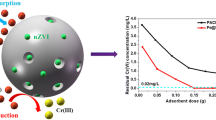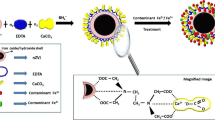Abstract
Heavy metals are a common contaminant in water supplies and pose a variety of serious health risks to nearby human populations. A promising approach to heavy metal decontamination is the sequestration of heavy metal ions in porous materials; however, current technologies involve materials which can be difficult to synthesize, are high-cost, or are themselves potentially toxic. Herein, we demonstrate that rapidly synthesized calcium carbonate (CaCO3) microparticles can effectively remove high quantities of Pb2+, Cd2+, and Cu2+ ions (1869, 1320, and 1293 mg per gram of CaCO3 microparticles, respectively) from aqueous media. The CaCO3 microparticles were characterized with powder X-ray diffraction (XRD), scanning electron microscopy (SEM), high-resolution transmission electron microscopy (HRTEM), and Brunauer–Emmett–Teller (BET) N2 sorption–desorption. It was found that the Ca2+ ions of the microparticles were replaced by the heavy metal ions, leading to partially recrystallized nanoparticles of new compositional phases such as cerussite (PbCO3). The adsorption, surface dissolution/re-precipitation, and nucleation/crystal growth mechanisms were determined by investigating the Ca2+ released, along with the changes to particle morphology and crystal structure. Importantly, this study demonstrates that the porous CaCO3 microparticles performed well in a system with multiple heavy metal ion species: 100% of Cu2+, 97.5% of Pb2+, and 37.0% Cd2+ were removed from an aqueous solution of all cations with initial individual metal concentrations of 50 mg/L and 1.5 g/L of CaCO3 microparticles. At this concentration, the CaCO3 microparticles significantly outperformed activated carbon. These results help to establish CaCO3 microparticles as a promising low-cost and scalable technology for removing heavy metal ions from contaminated water.

ᅟ






Similar content being viewed by others
References
Al-Rashdi, B., Johnson, D., & Hilal, N. (2013). Removal of heavy metal ions by nanofiltration. Desalination, 315, 2–17.
Amuda, O., Giwa, A., & Bello, I. (2007). Removal of heavy metal from industrial wastewater using modified activated coconut shell carbon. Biochemical Engineering Journal, 36, 174–181.
Annadurai, G., Juang, R., & Lee, D. (2003). Adsorption of heavy metals from water using banana and orange peels. Water Science and Technology, 47, 185–190.
Arshadi, M., Amiri, M., & Mousavi, S. (2014). Kinetic, equilibrium and thermodynamic investigations of Ni (II), Cd (II), Cu (II) and Co (II) adsorption on barley straw ash. Water Resources and Industry, 6, 1–17.
Aziz, H. A., Adlan, M. N., & Ariffin, K. S. (2008). Heavy metals (Cd, Pb, Zn, Ni, Cu and Cr (III)) removal from water in Malaysia: post treatment by high quality limestone. Bioresource Technology, 99, 1578–1583.
Blöcher, C., Dorda, J., Mavrov, V., Chmiel, H., Lazaridis, N., & Matis, K. (2003). Hybrid flotation-membrane filtration process for the removal of heavy metal ions from wastewater. Water Research, 37, 4018–4026.
Boparai, H. K., Joseph, M., & O’Carroll, D. M. (2011). Kinetics and thermodynamics of cadmium ion removal by adsorption onto nano zerovalent iron particles. Journal of Hazardous Materials, 186, 458–465.
Bushong, E. J., & Yoder, C. H. (2009). The synthesis and characterization of rouaite, a copper hydroxy nitrate. An integrated first-year laboratory project. Journal of Chemical Education, 86, 80.
Cai, G. B., Zhao, G. X., Wang, X. K., & Yu, S. H. (2010). Synthesis of polyacrylic acid stabilized amorphous calcium carbonate nanoparticles and their application for removal of toxic heavy metal ions in water. The Journal of Physical Chemistry C, 114, 12948–12954.
Celis, R., Hermosin, M. C., & Cornejo, J. (2000). Heavy metal adsorption by functionalized clays. Environmental Science & Technology, 34, 4593–4599.
Charerntanyarak, L. (1999). Heavy metals removal by chemical coagulation and precipitation. Water Science and Technology, 39, 135–138.
Erdem, E., Karapinar, N., & Donat, R. (2004). The removal of heavy metal cations by natural zeolites. Journal of Colloid and Interface Science, 280, 309–314.
Fu, F., & Wang, Q. (2011). Removal of heavy metal ions from wastewaters: a review. Journal of Environmental Management, 92, 407–418.
Gamsjäger, H., Fluch, A., & Swinehart, J. H. (1984). The effect of potential aqueous pollutants on the solubility of Pb2+ in cerussite-calcite phase. Monatshefte für Chemie/Chemical Monthly, 115, 251–259.
Garcıa-Sánchez, A., & Alvarez-Ayuso, E. (2002). Sorption of Zn, Cd and Cr on calcite. Application to purification of industrial wastewaters. Minerals Engineering, 15, 539–547.
Godelitsas, A., Astilleros, J. M., Hallam, K., Harissopoulos, S., & Putnis, A. (2003). Interaction of calcium carbonates with lead in aqueous solutions. Environmental Science & Technology, 37, 3351–3360.
Gupta, V. K., Agarwal, S., & Saleh, T. A. (2011). Synthesis and characterization of alumina-coated carbon nanotubes and their application for lead removal. Journal of Hazardous Materials, 185, 17–23.
Ho, Y. S., Wase, D. J., & Forster, C. (1996). Kinetic studies of competitive heavy metal adsorption by sphagnum moss peat. Environmental Technology, 17, 71–77.
Hong, K. S., Lee, H. M., Bae, J. S., Ha, M. G., Jin, J. S., Hong, T. E., Kim, J. P., & Jeong, E. D. (2011). Removal of heavy metal ions by using calcium carbonate extracted from starfish treated by protease and amylase. Journal of Analytical Science and Technology, 2, 75–82.
Hua, M., Zhang, S., Pan, B., Zhang, W., Lv, L., & Zhang, Q. (2012). Heavy metal removal from water/wastewater by nanosized metal oxides: a review. Journal of Hazardous Materials, 211, 317–331.
Jambor, J. L., Puziewicz, J., & Roberts, A. C. (1999). New mineral names. American Mineralogist, 84, 685–688.
Kobya, M., Demirbas, E., Senturk, E., & Ince, M. (2005). Adsorption of heavy metal ions from aqueous solutions by activated carbon prepared from apricot stone. Bioresource Technology, 96, 1518–1521.
Lin, S. H., Lai, S. L., & Leu, H. G. (2000). Removal of heavy metals from aqueous solution by chelating resin in a multistage adsorption process. Journal of Hazardous Materials, 76, 139–153.
Ma, X., Li, L., Yang, L., Su, C., Wang, K., & Jiang, K. (2012a). Preparation of hybrid CaCO3-pepsin hemisphere with ordered hierarchical structure and the application for removal of heavy metal ions. Journal of Crystal Growth, 338, 272–279.
Ma, X., Li, L., Yang, L., Su, C., Wang, K., Yuan, S., & Zhou, J. (2012b). Adsorption of heavy metal ions using hierarchical CaCO3–maltose meso/macroporous hybrid materials: adsorption isotherms and kinetic studies. Journal of Hazardous Materials, 209, 467–477.
Matlock, M. M., Howerton, B. S., & Atwood, D. A. (2002). Chemical precipitation of heavy metals from acid mine drainage. Water Research, 36, 4757–4764.
Mohammadifard, H., & Amiri, M. C. (2017). Evaluating Cu (II) removal from aqueous solutions with response surface methodology by using novel synthesized CaCO3 nanoparticles prepared in a colloidal gas aphron system. Chemical Engineering Communications, 204, 476–484.
Okoye, A., Ejikeme, P., & Onukwuli, O. (2010). Lead removal from wastewater using fluted pumpkin seed shell activated carbon: adsorption modeling and kinetics. International Journal of Environmental Science & Technology, 7, 793–800.
Pickering, W. (1983). Extraction of copper, lead, zinc or cadmium ions sorbed on calcium carbonate. Water, Air, & Soil Pollution, 20, 299–309.
Reed, B. E., & Matsumoto, M. R. (1993). Modeling cadmium adsorption by activated carbon using the Langmuir and Freundlich isotherm expressions. Separation Science and Technology, 28, 2179–2195.
Ren, C., Ding, X., Li, W., Wu, H., & Yang, H. (2017). Highly efficient adsorption of heavy metals onto novel magnetic porous composites modified with amino groups. Journal of Chemical & Engineering Data, 62, 1865–1875.
Ricco, R., Konstas, K., Styles, M. J., Richardson, J. J., Babarao, R., Suzuki, K., Scopece, P., & Falcaro, P. (2015). Lead (II) uptake by aluminium based magnetic framework composites (MFCs) in water. Journal of Materials Chemistry A, 3, 19822–19831.
Richardson, J. J., Maina, J. W., Ejima, H., Hu, M., Guo, J., Choy, M. Y., Gunawan, S. T., Lybaert, L., Hagemeyer, C. E., & De Geest, B. G. (2015). Versatile loading of diverse cargo into functional polymer capsules. Advanced Science, 2, 1400007.
Saha, D., Barakat, S., Van Bramer, S. E., Nelson, K. A., Hensley, D. K., & Chen, J. (2016). Noncompetitive and competitive adsorption of heavy metals in sulfur-functionalized ordered mesoporous carbon. ACS Applied Materials & Interfaces, 8, 34132–34142.
Sdiri, A., & Higashi, T. (2013). Simultaneous removal of heavy metals from aqueous solution by natural limestones. Applied Water Science, 3, 29–39.
Sdiri, A., Higashi, T., Chaabouni, R., & Jamoussi, F. (2012a). Competitive removal of heavy metals from aqueous solutions by montmorillonitic and calcareous clays. Water, Air, & Soil Pollution, 223, 1191–1204.
Sdiri, A., Higashi, T., Jamoussi, F., & Bouaziz, S. (2012b). Effects of impurities on the removal of heavy metals by natural limestones in aqueous systems. Journal of Environmental Management, 93, 245–253.
Srivastava, V. C., Mall, I. D., & Mishra, I. M. (2006). Equilibrium modelling of single and binary adsorption of cadmium and nickel onto bagasse fly ash. Chemical Engineering Journal, 117, 79–91.
Stafiej, A., & Pyrzynska, K. (2007). Adsorption of heavy metal ions with carbon nanotubes. Separation and Purification Technology, 58, 49–52.
Tavakoli, O., Goodarzi, V., Saeb, M. R., Mahmoodi, N. M., & Borja, R. (2017). Competitive removal of heavy metal ions from squid oil under isothermal condition by CR11 chelate ion exchanger. Journal of Hazardous Materials, 334, 256–266.
Wang, X., Cai, W., Lin, Y., Wang, G., & Liang, C. (2010a). Mass production of micro/nanostructured porous ZnO plates and their strong structurally enhanced and selective adsorption performance for environmental remediation. Journal of Materials Chemistry, 20, 8582–8590.
Wang, Y., Moo, Y. X., Chen, C., Gunawan, P., & Xu, R. (2010b). Fast precipitation of uniform CaCO 3 nanospheres and their transformation to hollow hydroxyapatite nanospheres. Journal of Colloid and Interface Science, 352, 393–400.
Wang, Z., Feng, Y., Hao, X., Huang, W., & Feng, X. (2014). A novel potential-responsive ion exchange film system for heavy metal removal. Journal of Materials Chemistry A, 2, 10263–10272.
Yavuz, O., Guzel, R., Aydin, F., Tegin, I., & Ziyadanogullari, R. (2007). Removal of cadmium and lead from aqueous solution by calcite. Polish Iournal of Environmental Studies, 16, 467.
Yoder, C., Bushong, E., Liu, X., Weidner, V., McWilliams, P., Martin, K., Lorgunpai, J., Haller, J., & Schaeffer, R. (2010). The synthesis and solubility of the copper hydroxyl nitrates: gerhardtite, rouaite and likasite. Mineralogical Magazine, 74, 433–440.
Acknowledgements
R. Zhang thanks the University of Sydney for a scholarship for her PhD study and the scientific and technical assistance, of the Australian Centre for Microscopy and Microanalysis (ACMM) Research Facility at the University of Sydney. Dr. Alexander K.Y. Yuen is acknowledged for his assistance with N2 sorption–desorption isotherm analysis. Dr. Shane Wilkinson is acknowledged for his support of ICP-OES analysis. Dr. Kang Liang acknowledges the support from the Scientia Fellowship program at UNSW.
Author information
Authors and Affiliations
Corresponding author
Electronic supplementary material
ESM 1
(DOCX 1181 kb)
Rights and permissions
About this article
Cite this article
Zhang, R., Richardson, J.J., Masters, A.F. et al. Effective Removal of Toxic Heavy Metal Ions from Aqueous Solution by CaCO3 Microparticles. Water Air Soil Pollut 229, 136 (2018). https://doi.org/10.1007/s11270-018-3787-0
Received:
Accepted:
Published:
DOI: https://doi.org/10.1007/s11270-018-3787-0




